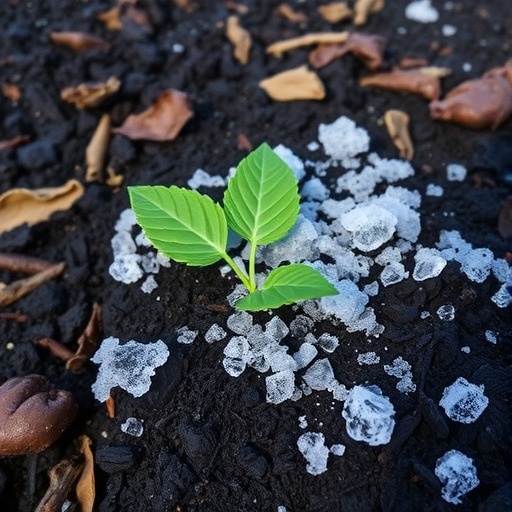Recent findings have cast new light on the assumed stability of biochar produced from livestock manure, a technique celebrated for its apparent environmental benefits. This carbon-rich material, generated through the pyrolysis of agricultural waste, has been widely championed as a dual-purpose tool: sequestering carbon to mitigate climate change while recycling waste to enhance soil fertility. However, emerging research now reveals that the environmental promises of biochar might be compromised under specific climatic stresses, especially those prevalent in regions with severe seasonal temperature fluctuations.
Researchers from Monash University and Xinjiang University recently published a comprehensive experimental study in the journal Biochar that challenges the prevailing assumption that biochar maintains its structural integrity and pollutant sequestration capabilities indefinitely. Their work specifically investigates how repetitive freeze–thaw cycles, characteristic of colder temperate zones, influence the physical stability of biochar and its capacity to immobilize heavy metals derived from livestock manure. Their findings underscore the complexity of biochar behavior in real-world environmental conditions, disrupting the simplistic notion of biochar as an unassailable “green” solution.
Freeze–thaw cycles cause pronounced mechanical stresses on biochar matrices. The research team simulated seasonal freezing and thawing processes and observed that these recurrent thermal fluctuations induce microcracks and oxidation on the surface of biochar particles. Surprisingly, biochars synthesized at higher pyrolysis temperatures—long believed to be more robust due to their denser carbon structures—exhibited the most significant susceptibility to structural degradation. This is a counterintuitive revelation that upends standard assumptions about how temperature during production influences long-term biochar durability in soil ecosystems.
The mechanical damage incurred through freeze–thaw aging is not merely a structural issue; it has profound chemical implications. As the biochar matrix fractures and oxidizes, heavy metals such as zinc, copper, and lead, previously immobilized within the biochar, are liberated into the surrounding environment. This remobilization risks enhancing the bioavailability of these toxic elements, posing hazards to crop health, soil microbiota, and potentially contaminating groundwater resources. These trace metals, when released in high concentrations, can disrupt sensitive ecological balances and undermine the safety of agricultural produce.
Quantitative analyses revealed alarming increases in the bioavailable fractions of heavy metals in aged biochar, with zinc and copper concentrations rising by orders of magnitude compared to freshly produced samples. Such elevated levels surpass regulatory thresholds established to protect plant health, indicating that the contrasting freeze–thaw conditions characteristic of many agricultural regions could undermine decades of environmental remediation efforts predicated on biochar stability.
This study compels a reconsideration of biochar production protocols, particularly the optimization of pyrolysis temperatures. The authors emphasize that higher temperature alone is inadequate as a safeguard against environmental degradation of biochar. Instead, they advocate for a nuanced understanding of how production parameters influence the physicochemical resilience of biochar under realistic environmental stressors, such as freeze–thaw cycles, ultraviolet exposure, and microbial activity.
From a broader perspective, the conclusions drawn from this research pose significant implications for the application of biochar in climate-smart agriculture. The deployment of biochar as a carbon sequestration tool and soil amendment must incorporate lifecycle assessments that factor in the environmental aging processes that modify biochar’s function over time. To overlook these dynamics risks both overestimating biochar’s climate mitigation potential and ignoring latent ecological hazards arising from pollutant re-release.
Addressing these challenges may necessitate innovative strategies to enhance the resilience of biochar in field conditions. Potential pathways include the development of protective surface treatments or the incorporation of stabilizing additives during or post-production to restrict heavy metal mobility. Such approaches would aim to mitigate the negative effects of freeze–thaw cycling and preserve biochar’s pollutant immobilization capabilities throughout its soil tenure.
The study also underscores the importance of interdisciplinary research combining materials science, environmental chemistry, and soil ecology to unravel the complex interactions governing biochar aging. Understanding the mechanisms of biochar oxidation and fracture, as well as the kinetics of heavy metal release, will be crucial in designing next-generation biochars tailored for durability and safety in diverse agroecosystems.
Moreover, the research brings to light a critical lesson in environmental technology implementation: the necessity of grounding laboratory and theoretical advances in the realities of natural ecosystems and climate variability. Technologies promising immediate payoffs may falter under long-term environmental conditions, highlighting the indispensability of robust, field-relevant testing regimes.
As biochar continues to attract interest for its multifaceted environmental benefits—from carbon storage to soil fertility and waste management—this study serves as a sober reminder that no single intervention can address complex ecological challenges in isolation. The quest for sustainable agriculture must therefore integrate adaptive management approaches that account for the temporally evolving performance of soil amendments like biochar.
In conclusion, while biochar remains a valuable tool in the environmental toolkit, its application cannot be decoupled from an awareness of its vulnerabilities under specific environmental stressors. This research opens new avenues for exploring how climate factors intersect with material science to influence pollutant dynamics, thus shaping best practices for biochar utilization in sustainable farming and global carbon management strategies.
Article Title: Reassessing the role of pyrolysis temperature: freeze–thaw aging challenges heavy metals stability in biochar
News Publication Date: 26-Jun-2025
References: Wang, X., Zhu, G., Yi, Y., et al. Reassessing the role of pyrolysis temperature: freeze–thaw aging challenges heavy metals stability in biochar. Biochar 7, 86 (2025). DOI: 10.1007/s42773-025-00479-7
Image Credits: Xingdong Wang, Guidan Zhu, Yuanrong Yi, Jin Zhou & Victor Wei-Chung Chang
Keywords
Carbon; Carbon cycle; Corrosion; Environmental chemistry




